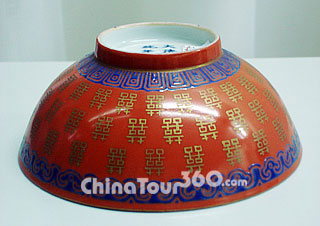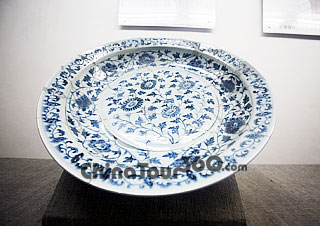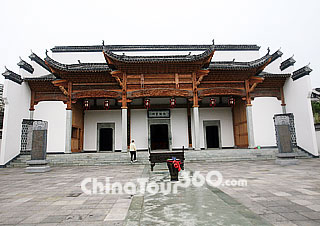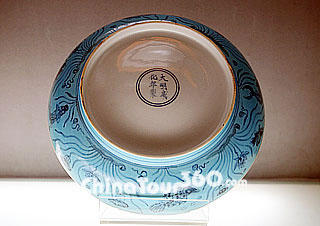 A Porcelain Bowl
A Porcelain Bowl A Procelain Plate
A Procelain Plate Site of The Imperial Kiln
Site of The Imperial Kiln A Peacock-green Plate
A Peacock-green Plate
Located at the transitional zone of the Mountain Huangshan, Mountain Huaiyu and the Poyang Lake, Jingdezhen, porcelain capital of China, is regarded as one of the four well-known towns in China, the other three being Foshan, Hankou and Zhuxian Town. It is designated as one of the first 24 famous Chinese cities of historical and cultural interests and a first-rate city opening to the foreigners by State Council of China.
Jingdezhen City was approved as a municipality under the direct jurisdiction of Jiangxi Province in 1953. It now covers an area of 5,256 square kilometers (2,029 square miles) with a population of 1,565,000 including 958,000 urban residents. Under its jurisdiction, there are Leping City, Fuliang County, Zhushan District and Changjiang District. It lies at longitudes 116°57' - 117°42' east and latitudes 28°44' - 29°56' south in the monsoon subtropical climate, enjoying enough sunshine, sufficient rainfall, and a mild and moist climate, with clearly demarcated four seasons. It has beautiful scenery featured by a network of many rivers and streams and a chain of mountain peaks one rising higher than another.
The city has a history of over, 1,600 years' ceramics making from the Han Dynasty (206 - 220 BC). The porcelain made in Jingdezhen is praised 'as white as jade, as thin as paper, as bright as a mirror'.Guo Moruo, a famous historian and scholar, highly praised in his poem that 'China is well known by the porcelain, the famous porcelains are made in this city'. Some ceramics spots in the city may be a must, which are the Western Suburban Old Kiln, Hutian Kiln, International Ceramics Exhibition Center, Jinxiu Changnan China Ceramics Garden as well as Jingdezhen Ceramics Museum. Meanwhile, it is also the area of glory revolutionary heritage, the famous Reorganization of the New Fourth Army ever happened in Yaoli town in Fuliang, Zhongpu Town in Leping was the cradle of the Red Tenth Army.
Jingdezhen is also rich in minerals such as porcelain stone, Kaolin, coal, tungsten, gold dust, cuprum, fluorite, sulphur, limestone, marble etc. Tea is another famous product in the city. As early as in the Tang Dynasty (618 - 907), it was the important tea-distributing center all over the country. At that time, the tax revenue of tea from Jingdezhen occupied 3/8 in the whole tax revenue of tea of the country.
In transportation, Hangru Expressway traverses the whole city from east to west, connecting Jingdezhen with Wuhan, Hefei, Nanjing, Nanchang, Shanghai and the cities of Zhejiang Province closely. To the north and south, there are Jiguang Expressway and National Highway 206. Its railway and air transport is also very convenient thanks to its high-speed economic development.







